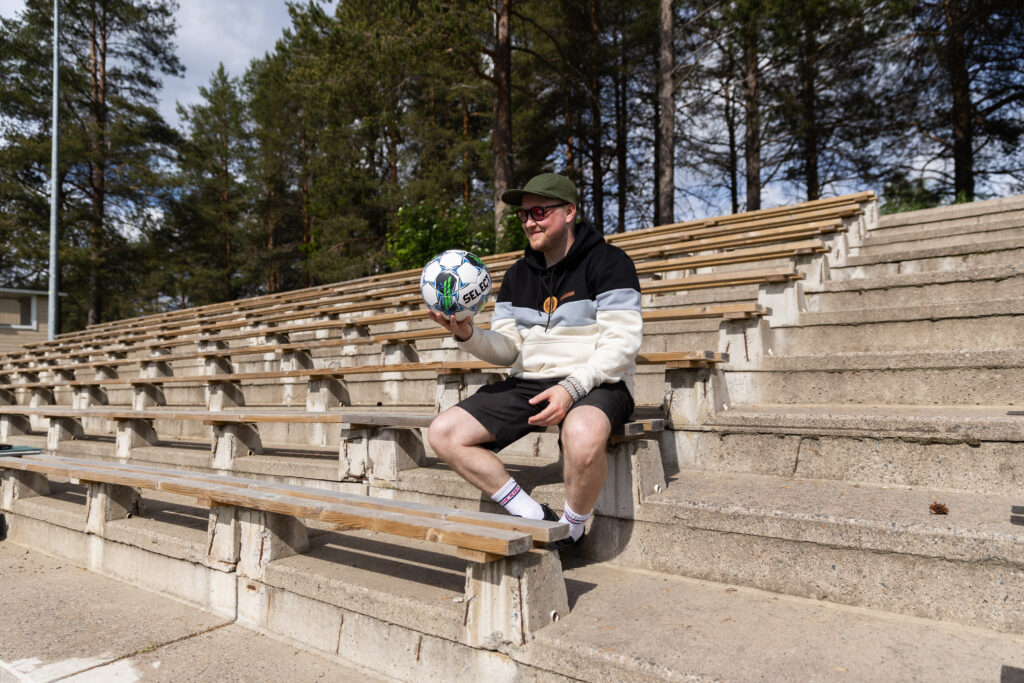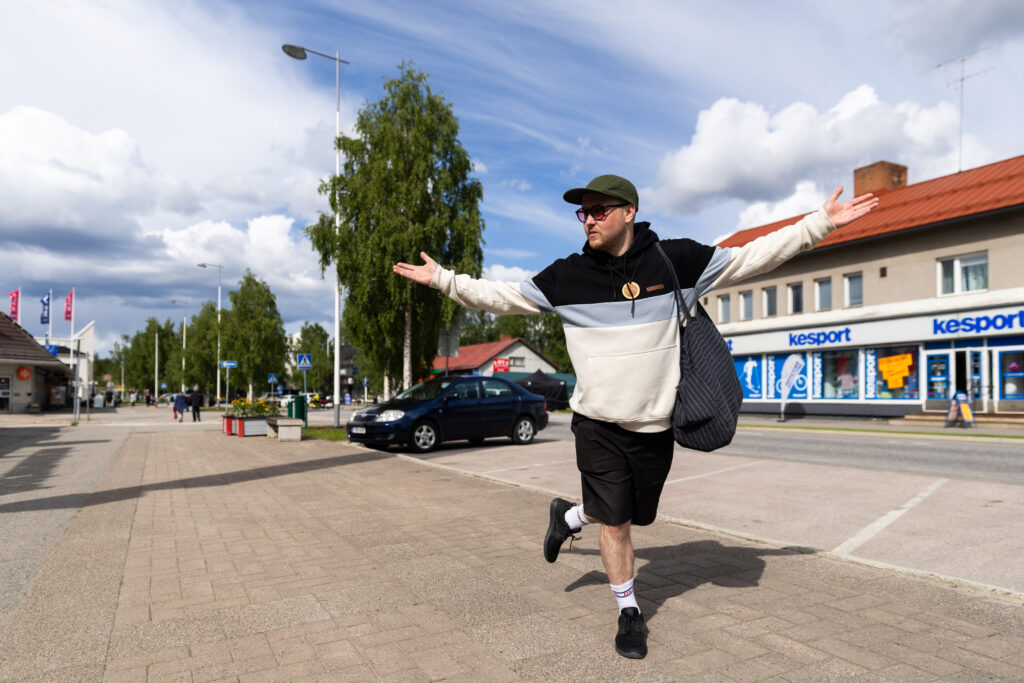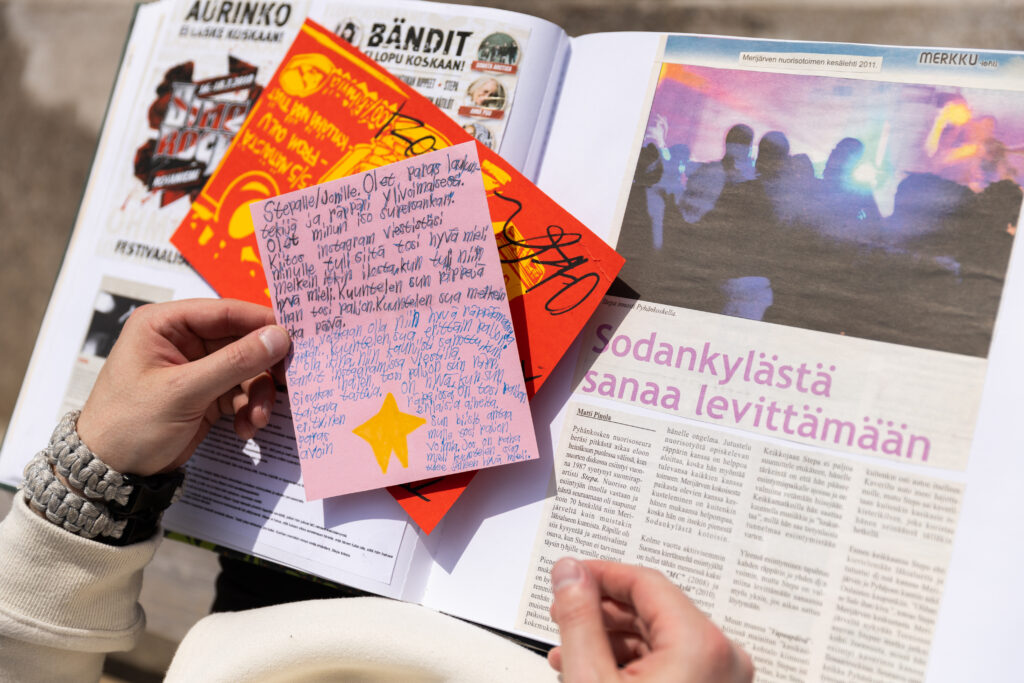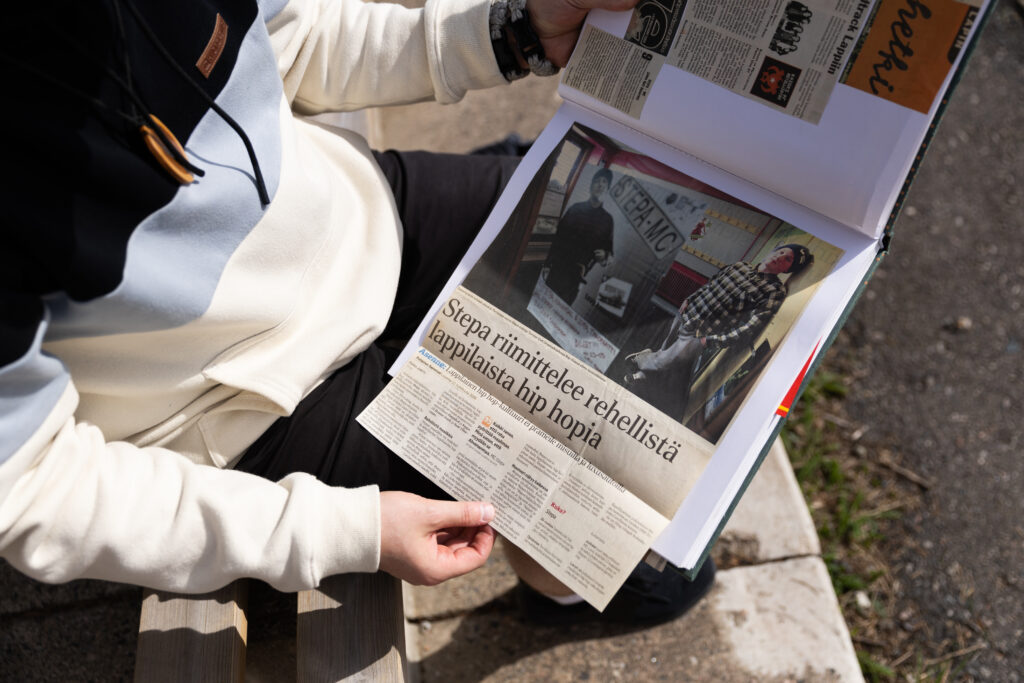Stepa thought for a long time that one couldn’t succeed in the north by writing poetry.
It turned out otherwise. The artist is often praised for their positivity, but life is more than that.

The main street of Sodankylä, Jäämerentie, looks almost the same as it did when Joni Stenberg, 37, the rap artist Stepa, rode his bike along it with his friends thirty years ago. The school day had ended, and the journey to the nearby soccer field was short.
After the first roundabout, there was the Vekkuli toy store on the left and a sports equipment store on the other side. The Rooperante restaurant later became a pizzeria. Otherwise, the atmosphere has remained almost the same. It’s unhurried, peaceful. A few hundred meters away, the Kitinen River flows.
– This is where I grew up, and this is the guy who came out of it, Stepa says, looking around. After that, he walks into a nearby café. It’s time for the first cups of coffee of the day.
Stepa’s first memories of music are from the fourth grade music games. At that time, he and his friends created different bands, beat cardboard boxes as drums, and wrote song lists.
At home, there were records, but no significant encouragement for music. From the record shelf, Stepa often chose Jope Ruonansuu, and from his stepfather’s collection, Motörhead. His mother liked Movetron. Ruonansuu’s lyrics made Stepaa, who liked history and sports, laugh.
Ruonansuu rapped about carefree life.
– It was only years later that I realized that Ruonansuu’s lyrics were my first encounter with rap.
At the same time, the breakthrough songs of Ezkimo and Fintelligens were playing on the radio. There was something about rap that immediately intrigued him.
At first, the excitement was related to stylish clothes, expensive cars, and popularity. Soon, the realization came about how the genre allowed one to express complex things concisely and effectively. Rap had power.
– Also, I always felt good when I listened to music. It was simply awesome.
One childhood memory stands out especially clearly. It was during a summer vacation trip to visit Grandma in Oulu. Stepa sat in the backseat of the car with his six-year-younger sister.
Near Rovaniemi, the radio played Kirka’s Varrella virran, and the siblings started singing. Their mother laughed. The siblings sang louder. The car was filled with sound. The moment still moves him.
– I still remember the joy and happiness I felt then. At the same time, I realized that my sister was no longer little. My sister is amazing. I admire her.
During middle and high school, making music began to take up more and more time. Swedish lessons were swapped for making beats, despite the annotations in the margins. When a friend moved into his own apartment in the center of Sodankylä, the group of friends got a rehearsal space.
– We had military-like discipline in what we did. When we agreed to be there at seven in the morning, we were at the door at five to.
Jouni Salminen deserves thanks several times over. He was the municipality’s outreach youth worker who saw the passion in the young people. So, Salminen opened the doors to the rehearsal space for those interested, almost always, regardless of the day or time.
This worked. The youth were trusted, so they were worthy of that trust. Music was made, belief in their own abilities grew, and enthusiasm to create developed.
– Jouni saved me and many others. I hope Sodankylä rewards the guy somehow. His significance is unquestionable, Stepa says, sipping his coffee.

During high school, the group of friends started organizing a monthly disco at the youth center in Veikkola. Performers were booked from their own town and as far as Ivalo.
About twenty years ago, Stepa decided to step onto the stage himself. Although the nerves were awful and there were several trips to the restroom before the gig, the desire to perform took precedence.
Stepa doesn’t remember what he performed or what he rapped about, but the euphoria that he caught from the stage is something he hasn’t forgotten. Before this, Stepa had only performed his rhymes to a few of his friends.
– When I got the mic in my hand, I asked the audience to stand up and clap. They stood up and clapped. That moment changed everything. I realized I could get a reaction. I wanted more.
In general, Stepa talks a lot about the power of small, positive encounters. About what might have happened if the audience hadn’t joined in or if Salminen hadn’t handed over the keys to the band room.
– I got experiences that supported me and pushed me forward.
In addition, a series of events pushed Stepa onto the path of becoming a musician. When Stepa was a teenager, he had two passions that divided his time: ice hockey and music. However, puberty didn’t hit him at the same time as it did for others, which made him feel embarrassed.
– When I tried to take a slap shot on the rink, the puck just slid along the ice. Everyone laughed at me. I had to come up with something else, so I threw myself into music even more.
Stepa says he only started speaking openly about his experience a few years ago. He does so to give strength to anyone who might be in a similar situation.
– You are not alone.
Slowly, the idea began to grow that music could also come from the North. The “Tulenkantajat” were gaining popularity, and Rollofunk was playing on the youth program Jyrki.
– Before, I thought that in Lapland, you couldn’t succeed by writing poetry. That people here only talked about mines. It seemed unlikely that a music career could work out. But it did.
After the matriculation exams in 2006, Stepa moved to Tornio to study youth work. Two years later, his first album was released, and MC received five stars from Rumba’s critic.
The album’s success meant that Stepa didn’t need to take out a student loan. He spent his weekdays studying and weekends performing. He continued his studies in primary school teaching at the University of Oulu.
The field felt natural, as his bonus siblings had taught him a lot. As a minor subject, Stepa studied special education and sociology.
– I’ve always liked working with children and young people. I also thought I should have a backup plan to fall back on if a music career didn’t work out.
Two years ago, Stepa had released seven albums. He took substitute teaching jobs at schools and worked in child protection. Life was steady and calm. Yet, something was missing.
One Friday, Gettomasa came to wait for his gig to start at Stepa’s living room in Oulu. The two watched rap videos and chatted. Before leaving, Gettomasa said to Stepa that he always tells young people how important it is to believe in their dreams and make them happen, but what about his own?
The words hit home.
– Gettomasa had been a fan of mine when he was younger and hoped I would make more music again. I had to get to work.
The following year, a collaborative album with Eevil Stöö was released. Stepa says Eevil Stöö was also a key figure in unlocking the last remaining barriers.
– When we started writing together, Eevil Stöö reminded me that we could make whatever kind of music we wanted. That was liberating.
Stepa pauses for a moment, thinking about how to continue. He says that he previously tried to avoid making music a full-time job and his only source of income.
– I was afraid that the magic of it would disappear if it became work, but that didn’t happen. It’s still the same as it was on my first gig. Magical.
Currently, Stepa does two to three gigs a month. The pace is perfect. Last summer, he toured all the requested festivals with Eevil Stöö, but this year is more relaxed.
And that’s good.
– I’ve seen many who have forgotten what they were passionate about and dreamed of as young people. I don’t want to be like that. Gigging still feels like joy, fun, and a privilege.
Stepa notes that he declines performance requests that don’t feel right. There’s only one rejection he regrets. Years ago, he was asked to perform at a motorcycle club celebration and at a church service in the same week.
He said no to both offers.
– I’ve regretted this afterward. I definitely should have gone to both.
Regarding musical dreams, Stepa says that he doesn’t really dream anymore. Things flow in their own time. At the beginning of his career, Stepa hoped it would be great to make an album and a music video. Both have come true.
But surely there’s something that excites you?
– It would be amazing to create a song that would feel like Mariska would fit into it. Or a collaborative album with Aren and Kriso. One day, I’ll perform with a band on the streets.
The artist says he has always made music in his own style, staying true to his values. A valuable piece of advice came from Asa during the time of his second album.
– Asa said that in the end, only Stepa knows best how Stepa should sound. That advice was brilliant. I thought, wow. Exactly. I’ve carried this with me.
Stepa states that money and music are currently in balance for him.
– I guess I could make more commercially successful songs, but this way I sleep well at night. You shouldn’t overthink what works and who’s listening; just make it from the heart.
That spring, the messages started pouring in. Stepa had just released his Henget album, and especially Oon 3 was getting airplay.
One particular message stood out. It came from a young girl. In her letter, she wrote how Stepa’s music had helped her get through tough times. Your music is like an older brother to me, she wrote.
Another moment that stuck with him was when a former drug user came to greet him after a show, thanking him for his work. My friend and I have gained strength from you.
– How can you respond to something like that except by saying thank you? Thank you for sharing that feedback.
These days, Stepa tries to reply to everyone who asks for his opinion on their music on social media.
– That’s something I can truly give my time to.

These moments capture why Stepa wants to create. To bring a better mood to his listeners. To make them dare, move, realize, or laugh. The role is familiar from childhood.
– I wasn’t the best or the most popular in school. That didn’t matter because I was the one who made people laugh. I still get excited when I can bring out a feeling in others.
Perhaps this is why Stepa is often called the most positive and optimistic rapper in the country. His coffee cools as Stepa admits to being sometimes confused by the title.
– I once thought I made songs about pain, sorrow, and uncertainty, but I was praised for my positivity.
The title doesn’t really bother him. It’s more about seeing each other as diverse. Not just through one template.
– On the other hand, if the world is dark, why would I make any more dark songs for it? I don’t claim to be as positive as it’s often said.

Stepa says he has seen a lot in his work with young people. During his first years in child protection, he would cry after workdays. One of his closest friends, rapper Edorf, passed away from cancer nine years ago. These experiences have shaped him.
– It’s already quite something that I’m here. My hands, legs, and head work. That makes me feel grateful.
Sodankylä 99600
The school building on the outskirts of the town is rundown. It’s no longer in use, while next to it, a new one shines. This is where Stepa attended middle school and listened to Wu-Tang Clan and Ice Cube with his friends during breaks. A new generation kicks a ball off to the side.
Stepa’s memories of Sodankylä are good. During childhood summers, the doors were always open, someone was always ready to meet, and there was space and security all around. The circles were small.
When Stepa looks at his old school, he says he wouldn’t have wanted to grow up anywhere else. He still dreams of one day moving back. However, that isn’t on the agenda for now. Stepa divides his time between Oulu, Tampere, and Helsinki.
– It would make the most sense to live in Helsinki, but I don’t want to. If we want to keep Finland alive and functioning, everything can’t focus on the capital region. Not even in the music business.
Next to the school, there is a soccer field. Stepa walks onto the field and pulls out a soccer ball and a speaker from his bag. Kaseva is playing on the playlist. Stepa is a member of the Oulu-based FC Kaiutinsarja amateur league team, which plays “at the lowest possible level.”
The most important thing is to have fun.
– Soccer has something in common with music. It makes you smile.
After kicking the ball for a while, Stepa sits on the edge of the field. The next day, he has a gig at the Sodankylä Film Festival, and today, a meeting with old friends in the town center. Just a few more questions.
Does anything ever make you angry?
– Wars make me angry, and so does it when someone with a gift throws it away. Why do so many give up the thing they love most when they reach a career or face the challenges of busy years?
Of course, there have been moments when Stepa has felt like giving up, but never seriously enough to decide to quit. He recalls a gig from the early days of his career when, after the show, he hopped on a train from Helsinki to Oulu.
During the journey, he got a fever, and he only had five euros.
– I was wondering whether to buy food or medicine when I got there. It sucked. Money was always tight, and the future was uncertain. But I still chose to continue, because this thing can’t be measured in money or success.
That’s why Stepa also thinks carefully about his performance venues. One of his favorites is Telakka in Tampere. The venue doesn’t hold as many people as other places, but it has a great atmosphere and a genuine vibe. That means a lot.
Also, the people we encounter play their roles. Those who, in moments of difficulty, have said, ‘Don’t give up. Believe in your dreams.’
A few years ago, at the Oulu Music Video Festival, Li Andersson came to praise and thank Stepa. After that, they sat in the same group. The whole evening, Stepa thought about how to thank her back. He wanted to say something, but he couldn’t because of his nerves.
‘When I walked home that night, I decided, that’s it. The shyness ends here.’
Even though encounters, new people, and performances still make him nervous, he now faces them more openly than before. Around his neck hangs a round wooden pendant. Stepa bought it from a local artisan.
‘He said this brings good spirits and beings around you. We believe in that.’
And creating. He can’t stop, because there is still something to say.

Seven years ago, Stepa wrote one of his most important songs. It’s called Kaunista ja hyvää (Beautiful and Good), and it ends like this:
Life is so beautiful and good.
This life is so beautiful and good.
So superficial, deep, cursed and sacred.
It hurts so much, it’s got to be made good.
Life is so beautiful and good.
Thank you.
The day’s coffee has been drunk, it’s time to go meet friends. On the field, a child kicks the ball into the goal.